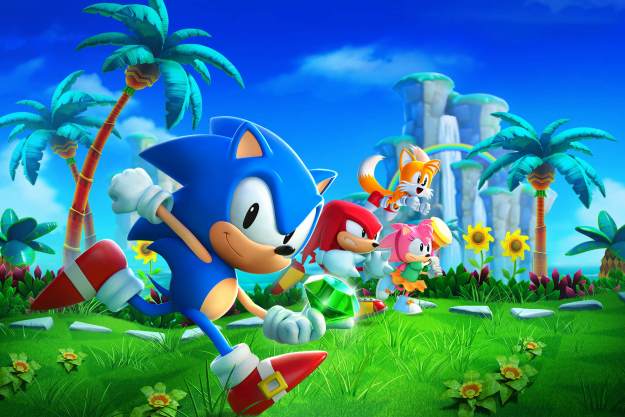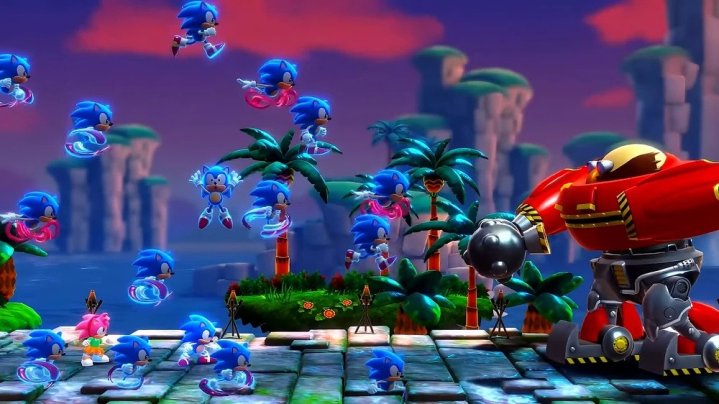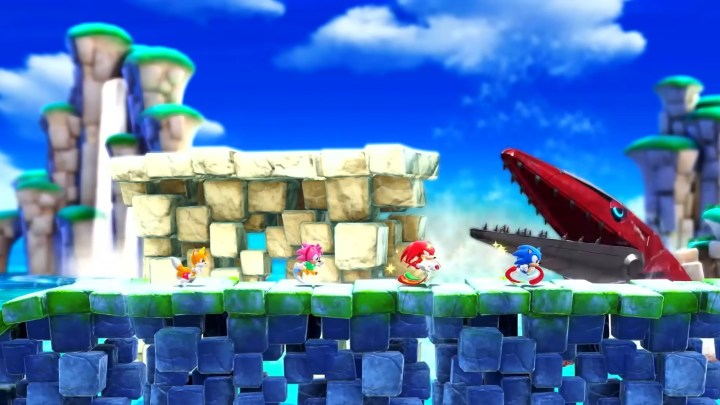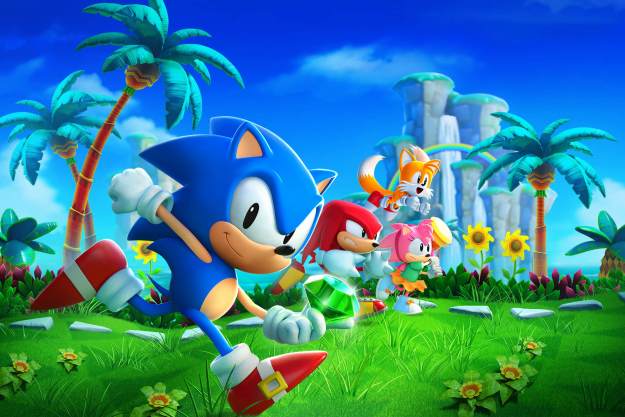
“Sonic Superstars nails the fundamentals of 2D Sonic design, but its new features don’t add much to the retro formula.”
- Great physics
- Excellent level design
- Multiple characters to play
- Battle mode is a fun extra
- Frustrating boss design
- Poorly implemented power-ups
- Disappointing aesthetics
- Poor multiplayer
Sonic’s slogan may be “Gotta go fast,” but Sonic Superstars shows that there’s value in slowing down every once and a while. Last year, the blue blur fearlessly bolted into the future with Sonic Frontiers, leaving nostalgia behind with a radical “open-zone” pivot that looked to modernize the series. It was an admirable move, though it took Sonic even further away from his roots with mixed results. It left me a little dizzy; I felt like I could no longer keep up with the series’ constantly changing identity.
Thankfully, the well-timed Sonic Superstars is a suitable remedy for that motion sickness. Rather than speeding forward with another messy reinvention, developers Arzest and Sonic Team slow the series’ roll to deliver the familiar 2D platformer some fans have been begging for. It’s not just an easy nostalgia play, though; this return to form tiptoes back to the heart of the series and seeks wisdom from what was once a winning formula. It’s as much a retro revival as it is a research expedition made to rediscover what made Sonic’s first adventures so special.
Sonic Superstars nails the fundamentals of the series’ best games with pitch-perfect physics and strong level design. The blast from the past unearths some old flaws along the way too in the form of frustrating bosses and momentum-killing digressions. Underwhelming new features don’t evolve the formula in any meaningful way, but Superstars is an important reset that lays the series’ best and worst qualities out for all to learn from.
Blast from the past
Sonic Superstars plays exactly like one of the blue blur’s Sega Genesis adventures, only replacing pixel art with smooth cartoon visuals. The hedgehog and his playable pals zip through a series of 2D stages filled with alternate pathways, rings, and well-hidden secrets. Sonic Team gets the important parts of that formula right. That starts with its familiar physics, which allows players to easily barrel through levels at high speeds while still being able to stop quickly and tackle a tricky platforming puzzle without sliding around. It feels exactly as I remember from my days as a Genesis kid, and that’s key to communicating what it was like to play those games in their heyday.
Also important to capturing that feeling is Superstars’ excellent level design. The intricately designed platforming stages are full of crisscrossing paths that seamlessly weave in and out of one another while you’re exploring. There’s also good reason to jump back into stages once clearing them to try new paths, as stages are loaded with collectible coins, fruits, and secret minigames.
Exploration is an act of pure childhood joy …
It’s while exploring those stages that I’m reminded what truly made those original 2D entries special. At their best, Sonic stages capture the essence of a playground. One minute I’m zipping downward on a slide-like ramp. Next thing I know, I’m flung into the air by a vine or bounced off a spring like a trampoline. Exploration is an act of pure childhood joy, and there’s always a reward for curiosity no matter what direction players end up in.
While not every zone is a winner, enough of them land to make Superstars an enjoyable platforming throwback. Pinball Carnival recaptures the stylish fun of Sonic 2’s casino zone, while Bridge Island is every bit as bright and breezy as Green Hill Zone. Granted, the game is light on original ideas. A chunk of zones have some sort of analog to previous ones, with only a few feeling particularly fresh. Cyber Station, for instance, includes a transformative voxel art twist that makes for its most memorable moment. Those creative swings are few and far between, leaving many zones without much personality beyond their nostalgic design cues.

The fast-paced platforming is at its best when I’m fluidly running through obstacles at full speed, like I’m riding a roller coaster. Unfortunately, it’s easy to lose momentum. Beyond some tricky obstacles that slow the action down at times, Superstars goes heavy on minigames that can kill the pace. There’s the series’ classic spinning maze bonus stage, a ring-collecting skydiving detour, and a Chaos Emerald minigame that has me swinging toward a floating jewel to unlock a new power-up. Each is a fine extra on its own, but stages are overloaded with them. In early levels, it felt like I was hopping into one every 20 seconds.
While completionists may find themselves exhausted by all the shiny distractions, Sonic Superstars is at its best when I’m simply zooming forward without a care in the world. The best secrets are the ones I bump into by accident, anyways.
Out with the new
While the fundamentals are squeaky clean, Sonic Superstars hits a lot of snags along the way. Boss fights, for instance, are a mixed bag of retro design. Some are a delightful throwback; I’ll always have a soft spot for fights where I need to satisfyingly bop an oversized Eggman robot on the head a few times while avoiding some easy to dodge attack patterns. Others create the adventure’s more frustrating moments. In one battle against a flying robot bird, I need to run across conveyor belts to keep up with it and dodge attacks. The tight physics get thrown out of whack as getting the right momentum to actually hit the bird can be difficult. An utterly disastrous final boss fight also had me ready to quit as I had to sit through drawn-out attack patterns for 10 minutes, only to repeatedly die due to poor chase scene physics at the tail end.
Powers largely aren’t worth the effort it takes to find them.
Other elements are more of a missed opportunity than an explicit problem. Superstars’ biggest addition is unlockable powers earned through Chaos Emeralds. Sonic and pals can gain the ability to summon a herd of clones to clear a screen or reveal invisible objects. It’s a fun twist in theory, but one that’s poorly executed. For example, they’re difficult to actually pull off on the fly. To activate one, I need to push in my right joystick and select a power. That’s not so easy to do, especially when I’m running through fast-paced levels. I’d usually have to stop dead if I wanted to use one, which is another momentum killer.
I’d be more inclined to stop and use them if they felt useful, but that’s the feature’s fundamental problem. Since all powers are entirely optional, levels are designed without them in mind. You seemingly don’t need to use a single one to find any secret, though it may make the task a little easier. A power that turns players into water, allowing them to climb up waterfalls, is useless in most stages. When I first tried to use my clone herd ability in a boss fight, I was disappointed to see it had no effect on the boss I was fighting. They largely aren’t worth the effort it takes to find them.

Superstars’ new aesthetic design isn’t much of a winner, either. Sega tries to strike a balance between new and retro with a cartoony 2.5D art style, but it’s often lacking in personality. Flat colors and soft textures don’t do stages like the sunny Lagoon City justice, which is a shame considering the series’ history of meticulously detailed art design. Music similarly fails to stand out as it reaches for some forgettable retro fare.
I played the Nintendo Switch version of the game, which makes matters even worse. In addition to some jagged visuals, I experienced frequent stutters on the platform. That especially made some of those chase scene boss fights even more frustrating, as I lost plenty of lives due to frame hiccups.
Modes and multiplayer
Sonic Superstars‘ big back-of-the-box feature is its emphasis on multiplayer, though that’s not as much of a selling point as it seems. In local co-op, up to four players can adventure together. However, the camera only tracks whichever player is furthest ahead in the course — something that’s fairly difficult to deduce in fast-paced, twisty levels. It’s the kind of multiplayer implementation that’ll leave players who can’t keep pace barely playing at all as they’re teleported back to their friend.

Fortunately, the inclusion of co-op does make the solo experience better. From the jump, Superstars features four playable characters, each of which has their own traversal gimmick. Tails can use his helicopter tail to fly vertically, Knuckles can climb walls, and Amy Rose has a double jump. Each ability totally changes how players can explore a stage, making hard-to-reach routes more easily accessible depending on the character. It’s essentially the concept of the new Chaos Emerald powers, but delivered in a more natural way.
A pair of extra modes are a little more suited to that multiplayer design, though mileage may vary. Battle Mode is a cute minigame gauntlet that delivers harmless fun. Here, players customize a mech avatar (by spending Sonic coins earned during the adventure) and compete in three rounds of challenges. These can be as simple as surviving long enough in a falling platform battle or collecting the most stars in a level. It’s no Fall Guys, but character customization and tracked stats give players a little progression to work toward.
Superstars never quite figures out the right side dish to bring to the retro table.
There’s also a Time Attack mode, which seems like a slam dunk on paper. Run through a stage as fast as possible and put your time on a leaderboard — simple, right? Oddly enough, that easy win is complicated. If players lag too much in a stage, they’re abruptly kicked back to the beginning, with no hope of making up lost time. The rules aren’t explained anywhere, so I’m not really sure what causes that fail state. I expected to spend most of my time after beating the story trying to get the fastest time possible, but the only speedrun I pulled off was my “time to quit.”
All of these issues began to add up by the end of my time with Sonic Superstars. While I was immediately smitten as I zipped through Bridge Island with familiar speed, those returns diminished the deeper I got into messier later levels and underwhelming extra modes. Nostalgia is only a starting point, something the developers behind Sonic Mania understood incredibly well. That game hit all the right notes, but still found ways to loop in the studio’s own creativity (who can forget the excellent Mean Bean Machine boss fight?). Superstars never quite figures out the right side dish to bring to the retro table. It’s a fun pit stop on Sonic’s decades’ long marathon, but I don’t imagine Sega will spend much time-tuning the series here before it’s on to the next idea.
Gotta go fast, as they say.
Sonic Superstars was tested on a Nintendo Switch OLED in handheld mode and on a TCL 6-Series R635 when docked.
Editors’ Recommendations
Services Marketplace – Listings, Bookings & Reviews
